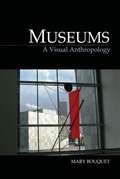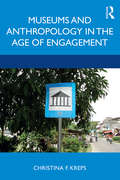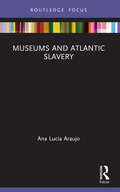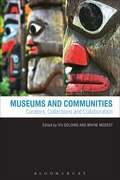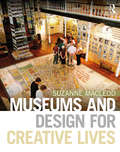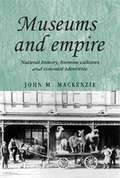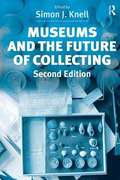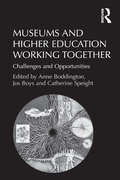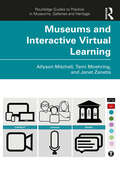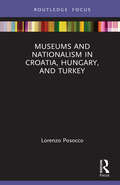- Table View
- List View
Museums: A Visual Anthropology (Key Texts in the Anthropology of Visual and Material Culture)
by Mary BouquetMuseums: A Visual Anthropology provides a clear and concise summary of the key ideas, debates and texts of the most important approaches to the study of museums from around the world. The book examines ways to address the social relations of museums, embedded in their sites, collections, and exhibitions, as an integral part of the visual and material culture they comprise. Cross-disciplinary in scope, Museums uses ideas and approaches both from within and outside of anthropology to further students' knowledge of and interest in museums. Including selected, globally based case studies to highlight and exemplify important issues, the book also contains suggested Further Reading for each chapter, for students to expand their learning independently. Exploring fundamental methods and approaches to engage this constantly evolving time machine, Museums will be essential reading for students of anthropology and museum studies.
Museums: A Visual Anthropology (Key Texts in the Anthropology of Visual and Material Culture #23)
by Mary BouquetMuseums: A Visual Anthropology provides a clear and concise summary of the key ideas, debates and texts of the most important approaches to the study of museums from around the world. The book examines ways to address the social relations of museums, embedded in their sites, collections, and exhibitions, as an integral part of the visual and material culture they comprise. Cross-disciplinary in scope, Museums uses ideas and approaches both from within and outside of anthropology to further students' knowledge of and interest in museums. Including selected, globally based case studies to highlight and exemplify important issues, the book also contains suggested Further Reading for each chapter, for students to expand their learning independently. Exploring fundamental methods and approaches to engage this constantly evolving time machine, Museums will be essential reading for students of anthropology and museum studies.
Museums and Anthropology in the Age of Engagement
by Christina KrepsMuseums and Anthropology in the Age of Engagement considers changes that have been taking place in museum anthropology as it has been responding to pressures to be more socially relevant, useful, and accountable to diverse communities. Based on the author’s own research and applied work over the past 30 years, the book gives examples of the wide-ranging work being carried out today in museum anthropology as both an academic, scholarly field and variety of applied, public anthropology. While it examines major trends that characterize our current "age of engagement," the book also critically examines the public role of museums and anthropology in colonial and postcolonial contexts, namely in the US, the Netherlands, and Indonesia. Throughout the book, Kreps questions what purposes and interests museums and anthropology serve in these different times and places. Museums and Anthropology in the Age of Engagement is a valuable resource for readers interested in an historical and comparative study of museums and anthropology, and the forms engagement has taken. It should be especially useful to students and instructors looking for a text that provides in one volume a history of museum anthropology and methods for doing critical, reflexive museum ethnography and collaborative work.
Museums and Anthropology in the Age of Engagement
by Christina KrepsMuseums and Anthropology in the Age of Engagement considers changes that have been taking place in museum anthropology as it has been responding to pressures to be more socially relevant, useful, and accountable to diverse communities. Based on the author’s own research and applied work over the past 30 years, the book gives examples of the wide-ranging work being carried out today in museum anthropology as both an academic, scholarly field and variety of applied, public anthropology. While it examines major trends that characterize our current "age of engagement," the book also critically examines the public role of museums and anthropology in colonial and postcolonial contexts, namely in the US, the Netherlands, and Indonesia. Throughout the book, Kreps questions what purposes and interests museums and anthropology serve in these different times and places. Museums and Anthropology in the Age of Engagement is a valuable resource for readers interested in an historical and comparative study of museums and anthropology, and the forms engagement has taken. It should be especially useful to students and instructors looking for a text that provides in one volume a history of museum anthropology and methods for doing critical, reflexive museum ethnography and collaborative work.
Museums and Atlantic Slavery (Museums in Focus)
by Ana Lucia AraujoMuseums and Atlantic Slavery explores how slavery, the Atlantic slave trade, and enslaved people are represented through words, visual images, artifacts, and audiovisual materials in museums in Europe and the Americas. Divided into four chapters, the book addresses four recurrent themes: wealth and luxury; victimhood and victimization; resistance and rebellion; and resilience and achievement. Considering the roles of various social actors who have contributed to the introduction of slavery in the museum in the last thirty years, the analysis draws on selected exhibitions, and institutions entirely dedicated to slavery, as well as national, community, plantation, and house museums in the United States, England, France, and Brazil. Engaging with literature from a range of disciplines, including history, anthropology, sociology, art history, tourism and museum studies, Araujo provides an overview of a topic that has not yet been adequately discussed and analysed within the museum studies field. Museums and Atlantic Slavery encourages scholars, students, and museum professionals to critically engage with representations of slavery in museums. The book will help readers to recognize how depictions of human bondage in museums and exhibitions often fail to challenge racism and white supremacy inherited from the period of slavery.
Museums and Atlantic Slavery (Museums in Focus)
by Ana Lucia AraujoMuseums and Atlantic Slavery explores how slavery, the Atlantic slave trade, and enslaved people are represented through words, visual images, artifacts, and audiovisual materials in museums in Europe and the Americas. Divided into four chapters, the book addresses four recurrent themes: wealth and luxury; victimhood and victimization; resistance and rebellion; and resilience and achievement. Considering the roles of various social actors who have contributed to the introduction of slavery in the museum in the last thirty years, the analysis draws on selected exhibitions, and institutions entirely dedicated to slavery, as well as national, community, plantation, and house museums in the United States, England, France, and Brazil. Engaging with literature from a range of disciplines, including history, anthropology, sociology, art history, tourism and museum studies, Araujo provides an overview of a topic that has not yet been adequately discussed and analysed within the museum studies field. Museums and Atlantic Slavery encourages scholars, students, and museum professionals to critically engage with representations of slavery in museums. The book will help readers to recognize how depictions of human bondage in museums and exhibitions often fail to challenge racism and white supremacy inherited from the period of slavery.
The Museums and Collections of Higher Education
by Andrew SimpsonThe Museums and Collections of Higher Education provides an analysis of the historic connections between materiality and higher education, developed through diverse examples of global practice. Outlining the different value propositions that museums and collections bring to higher education, the historic link between objects, evidence and academic knowledge is examined with reference to the origin point of both types of organisation. Museums and collections bring institutional reflection, cross-disciplinary bridges, digital extension options and participatory potential. Given the two primary sources of text and object, a singular source type predisposes a knowledge system to epistemic stasis, whereas mixed sources develop the potential for epistemic disruption and possible change. Museums and collections, therefore, are essential in the academies of higher learning. With the many challenges confronting humanity, it is argued that connecting intellect with social action for societal change through university museums should be a contemporary manifestation of the social contract of universities. Much has been written about museums and universities, but there is little about university museums and collections. This book will interest museum scholars and practitioners especially those unaware that university museums are at the forefront of museological creativity. It will also be of interest to academics and the growing number of leaders and managers in the modern university.
The Museums and Collections of Higher Education
by Andrew SimpsonThe Museums and Collections of Higher Education provides an analysis of the historic connections between materiality and higher education, developed through diverse examples of global practice. Outlining the different value propositions that museums and collections bring to higher education, the historic link between objects, evidence and academic knowledge is examined with reference to the origin point of both types of organisation. Museums and collections bring institutional reflection, cross-disciplinary bridges, digital extension options and participatory potential. Given the two primary sources of text and object, a singular source type predisposes a knowledge system to epistemic stasis, whereas mixed sources develop the potential for epistemic disruption and possible change. Museums and collections, therefore, are essential in the academies of higher learning. With the many challenges confronting humanity, it is argued that connecting intellect with social action for societal change through university museums should be a contemporary manifestation of the social contract of universities. Much has been written about museums and universities, but there is little about university museums and collections. This book will interest museum scholars and practitioners especially those unaware that university museums are at the forefront of museological creativity. It will also be of interest to academics and the growing number of leaders and managers in the modern university.
Museums and Communities: Curators, Collections and Collaboration
by Viv Golding Wayne ModestThis edited volume critically engages with contemporary scholarship on museums and their engagement with the communities they purport to serve and represent. Foregrounding new curatorial strategies, it addresses a significant gap in the available literature, exploring some of the complex issues arising from recent approaches to collaboration between museums and their communities.The book unpacks taken-for-granted notions such as scholarship, community, participation and collaboration, which can gloss over the complexity of identities and lead to tokenistic claims of inclusion by museums. Over sixteen chapters, well-respected authors from the US, Australia and Europe offer a timely critique to address what happens when museums put community-minded principles into practice, challenging readers to move beyond shallow notions of political correctness that ignore vital difference in this contested field. Contributors address a wide range of key issues, asking pertinent questions such as how museums negotiate the complexities of integrating collaboration when the target community is a living, fluid, changeable mass of people with their own agendas and agency. When is engagement real as opposed to symbolic, who benefits from and who drives initiatives? What particular challenges and benefits do artist collaborations bring? Recognising the multiple perspectives of community participants is one thing, but how can museums incorporate this successfully into exhibition practice?Students of museum and cultural studies, practitioners and everyone who cares about museums around the world will find this volume essential reading.
Museums and Communities: Curators, Collections and Collaboration
by Viv Golding Wayne ModestThis edited volume critically engages with contemporary scholarship on museums and their engagement with the communities they purport to serve and represent. Foregrounding new curatorial strategies, it addresses a significant gap in the available literature, exploring some of the complex issues arising from recent approaches to collaboration between museums and their communities.The book unpacks taken-for-granted notions such as scholarship, community, participation and collaboration, which can gloss over the complexity of identities and lead to tokenistic claims of inclusion by museums. Over sixteen chapters, well-respected authors from the US, Australia and Europe offer a timely critique to address what happens when museums put community-minded principles into practice, challenging readers to move beyond shallow notions of political correctness that ignore vital difference in this contested field. Contributors address a wide range of key issues, asking pertinent questions such as how museums negotiate the complexities of integrating collaboration when the target community is a living, fluid, changeable mass of people with their own agendas and agency. When is engagement real as opposed to symbolic, who benefits from and who drives initiatives? What particular challenges and benefits do artist collaborations bring? Recognising the multiple perspectives of community participants is one thing, but how can museums incorporate this successfully into exhibition practice?Students of museum and cultural studies, practitioners and everyone who cares about museums around the world will find this volume essential reading.
Museums and Design Education: Looking to Learn, Learning to See
by Rebecca ReynoldsHow can museum educators and higher education tutors enhance the way HE students use museums? There are many examples in the UK of museums and universities working together in productive and innovative ways, but these relationships tend to be based on individual enthusiasm and opportunistic arrangements. Despite the growing importance of museum education departments, higher education tends to be overlooked by museums. This book looks at the interaction between design students and museums, and explores issues, projects and emerging ideas about how museums can better support HE students. It illustrates the general lessons that can be learnt, both strategic and practical, which can help to bring about long-term and constructive relationships between museums and universities in order to enable effective student learning.
Museums and Design Education: Looking to Learn, Learning to See
by Rebecca ReynoldsHow can museum educators and higher education tutors enhance the way HE students use museums? There are many examples in the UK of museums and universities working together in productive and innovative ways, but these relationships tend to be based on individual enthusiasm and opportunistic arrangements. Despite the growing importance of museum education departments, higher education tends to be overlooked by museums. This book looks at the interaction between design students and museums, and explores issues, projects and emerging ideas about how museums can better support HE students. It illustrates the general lessons that can be learnt, both strategic and practical, which can help to bring about long-term and constructive relationships between museums and universities in order to enable effective student learning.
Museums and Design for Creative Lives
by Suzanne MacLeodMuseums and Design for Creative Lives questions what we sacrifice when we allow economic imperatives to shape public museums, whilst also considering the implications of these new museum realities. It also asks: how might we instead design for creative lives? Drawing together 28 case studies of museum design spanning 70 years, the book explores the spatial and social forms that comprise these successful examples, as well as the design methodologies through which they were produced. Re-activating a well-trodden history of progressive museum design and raising awareness of the involvement of the built forms in how we feel, think and act, MacLeod provides strategies and methods to actively counter the economisation of museums and a call to museum makers to work beyond the economic and advance this deeply human history of museum making. Museums and Design for Creative Lives will be of great interest to academics and students in museum studies, gallery studies, heritage studies, arts management, communication and architecture and design departments, as well as those interested in understanding more about design as a resource in museums. The book provides a valuable resource for museum leaders and practitioners.
Museums and Design for Creative Lives
by Suzanne MacLeodMuseums and Design for Creative Lives questions what we sacrifice when we allow economic imperatives to shape public museums, whilst also considering the implications of these new museum realities. It also asks: how might we instead design for creative lives? Drawing together 28 case studies of museum design spanning 70 years, the book explores the spatial and social forms that comprise these successful examples, as well as the design methodologies through which they were produced. Re-activating a well-trodden history of progressive museum design and raising awareness of the involvement of the built forms in how we feel, think and act, MacLeod provides strategies and methods to actively counter the economisation of museums and a call to museum makers to work beyond the economic and advance this deeply human history of museum making. Museums and Design for Creative Lives will be of great interest to academics and students in museum studies, gallery studies, heritage studies, arts management, communication and architecture and design departments, as well as those interested in understanding more about design as a resource in museums. The book provides a valuable resource for museum leaders and practitioners.
Museums and empire: Natural history, human cultures and colonial identities (Studies in Imperialism #76)
by John M. MacKenzieMuseums and Empire is the first book to examine the origins and development of museums in six major regions if the British Empire in the nineteenth and twentieth centuries. It analyses museum histories in thirteen major centres in Canada, South Africa, Australia, New Zealand, India and South-East Asia, setting them into the economic and social contexts of the cities and colonies in which they were located. Written in a lively and informative style, it also touches upon the history of many other museums in Britain and other territories of the Empire. A number of key themes emerge from its pages; the development of elites within colonial towns and cities; the emergence of the full range of cultural institutions associated with this; and the reception and modification of the key scientific ideas of the age. It will be essential reading for students and academics concerned with museum studies and imperial history and to a wider public devoted to the cause of museums and heritage
Museums And The Future Of Collecting
by Simon J. KnellCollecting is a key function of museums. Its apparent simplicity belies a complexity of questions and issues which make all collecting imprecise and unrepresentative. This book exposes the many meanings of collections, the different perspectives taken by different cultures, and the institutional response to the collecting problem. One major concern is omission, whether this be determined by politics, professional ethics, the law or social agenda. How did curators collect during the war in Croatia? What were the problems of trying to collect the #65533;old#65533; South Africa when the new one was born? Can museums collect from groups which seem to #65533;deviate#65533; from society#65533;s norms? How has the function of museums affected the practices of international trade? Can museums collect successfully if collecting agenda are being set externally? Museums and the Future of Collecting encourages museums to move away from the collecting of isolated tokens; to move beyond the collecting policy and to understand more clearly the intellectual function of what they do. Here examples are given from Australia, Sweden, Canada, Spain, Britain and Croatia which provide this intellectual understanding and many practical tools for evaluating a future collecting strategy.
Museums And The Future Of Collecting (PDF)
by Simon J. KnellCollecting is a key function of museums. Its apparent simplicity belies a complexity of questions and issues which make all collecting imprecise and unrepresentative. This book exposes the many meanings of collections, the different perspectives taken by different cultures, and the institutional response to the collecting problem. One major concern is omission, whether this be determined by politics, professional ethics, the law or social agenda. How did curators collect during the war in Croatia? What were the problems of trying to collect the #65533;old#65533; South Africa when the new one was born? Can museums collect from groups which seem to #65533;deviate#65533; from society#65533;s norms? How has the function of museums affected the practices of international trade? Can museums collect successfully if collecting agenda are being set externally? Museums and the Future of Collecting encourages museums to move away from the collecting of isolated tokens; to move beyond the collecting policy and to understand more clearly the intellectual function of what they do. Here examples are given from Australia, Sweden, Canada, Spain, Britain and Croatia which provide this intellectual understanding and many practical tools for evaluating a future collecting strategy.
Museums and Higher Education Working Together: Challenges and Opportunities
by Jos BoysOver the last twenty years the educational role of the museum has come to be central to its mission. There are now far more educational opportunities, new spaces, new interfaces - both digital and physical, and a growing number of education and interpretation departments, educational curators and public engagement programmes. Despite these developments, however, higher education has remained a marginal collaborator compared to primary and secondary schools and to other forms of adult learning. This has meant that the possibilities for partnerships between universities, colleges, museums and galleries has remained relatively unexplored, especially in relation to their potential for generating innovative patterns of research and learning. This book addresses the key issues which are preventing such partnerships and examines how to enable more effective and creative connections between museums and higher education. The authors identify conceptual and practical barriers and explore whether current academic models are fit for purpose. They argue that as pressures mount on public educational resources around the world, there needs to be an urgent increase in the exchange of knowledge across these sectors and the forging of world-class scholarly partnerships. Examples of research undertaken internationally offer best practice models for collaboration and integration. This book will be compulsory reading for museum and educational specialists and those interested in engaging in museum/higher education partnerships. It will also be of interest to those involved in policy and decision-making in education, the museum sector and national and local government.
Museums and Higher Education Working Together: Challenges and Opportunities
by Jos BoysOver the last twenty years the educational role of the museum has come to be central to its mission. There are now far more educational opportunities, new spaces, new interfaces - both digital and physical, and a growing number of education and interpretation departments, educational curators and public engagement programmes. Despite these developments, however, higher education has remained a marginal collaborator compared to primary and secondary schools and to other forms of adult learning. This has meant that the possibilities for partnerships between universities, colleges, museums and galleries has remained relatively unexplored, especially in relation to their potential for generating innovative patterns of research and learning. This book addresses the key issues which are preventing such partnerships and examines how to enable more effective and creative connections between museums and higher education. The authors identify conceptual and practical barriers and explore whether current academic models are fit for purpose. They argue that as pressures mount on public educational resources around the world, there needs to be an urgent increase in the exchange of knowledge across these sectors and the forging of world-class scholarly partnerships. Examples of research undertaken internationally offer best practice models for collaboration and integration. This book will be compulsory reading for museum and educational specialists and those interested in engaging in museum/higher education partnerships. It will also be of interest to those involved in policy and decision-making in education, the museum sector and national and local government.
Museums and Interactive Virtual Learning (Routledge Guides to Practice in Museums, Galleries and Heritage)
by Allyson Mitchell Tami Moehring Janet ZanetisMuseums and Interactive Virtual Learning provides informal educators with practical resources that will help them to build dynamic digital engagement experiences within their own cultural organizations. Presenting vignettes from experienced museum educators and end users, as well as scientific data and practical resources, the book highlights the mutual benefits that Interactive Virtual Learning (IVL) programs offer to the museum and those visiting from a distance. Chapters mirror the step-by-step process of developing reputable IVL programs and emphasize how important it is for cultural organizations to encourage cross-departmental collaboration, if they wish to ensure that their programs align with the overall goals of the organization. Providing a thorough overview of the technologies, budget, marketing and staff requirements, the authors offer a realistic depiction of the work involved in building content for digital engagement. Emphasizing the importance of assessing existing programming, the book shows how institutions can adapt content to fit a virtual format and create inclusive digital engagement opportunities that reach local, national, and international audiences. Museums and Interactive Virtual Learning is an essential guide for professionals who are tasked with interpreting the content of a cultural organization and building lasting digital engagement opportunities. It will be particularly useful to those looking to reach diverse audiences.
Museums and Interactive Virtual Learning (Routledge Guides to Practice in Museums, Galleries and Heritage)
by Allyson Mitchell Tami Moehring Janet ZanetisMuseums and Interactive Virtual Learning provides informal educators with practical resources that will help them to build dynamic digital engagement experiences within their own cultural organizations. Presenting vignettes from experienced museum educators and end users, as well as scientific data and practical resources, the book highlights the mutual benefits that Interactive Virtual Learning (IVL) programs offer to the museum and those visiting from a distance. Chapters mirror the step-by-step process of developing reputable IVL programs and emphasize how important it is for cultural organizations to encourage cross-departmental collaboration, if they wish to ensure that their programs align with the overall goals of the organization. Providing a thorough overview of the technologies, budget, marketing and staff requirements, the authors offer a realistic depiction of the work involved in building content for digital engagement. Emphasizing the importance of assessing existing programming, the book shows how institutions can adapt content to fit a virtual format and create inclusive digital engagement opportunities that reach local, national, and international audiences. Museums and Interactive Virtual Learning is an essential guide for professionals who are tasked with interpreting the content of a cultural organization and building lasting digital engagement opportunities. It will be particularly useful to those looking to reach diverse audiences.
Museums and Nationalism in Croatia, Hungary, and Turkey
by Lorenzo PosoccoMuseums and Nationalism in Croatia, Hungary, and Turkey draws attention to museums as political productions of the nation-state and shows how they can be shaped by the political forces that rule a country. Drawing on case studies and interviews from Croatia, Hungary, and Turkey, the book investigates how the past has been exploited to serve the interests of nationalism in the twenty-first century, and how museums themselves are exploited to serve nationalist ideologies. Posocco argues that, in a world of nation-states where nationalism is the dominant ideology, all museums are national museums, even when they aren't. In this perspective, they can (and do, in the case studies under analysis in this book) become the cultural offshoots of political wars, places where the national past is contested, rewritten, and sometimes even created from scratch, and finally exhibited. Paying particular attention to the decision-making and economic aspects of the museum, the book also examines the micro-sociological and political aspects, which will be the foundation for further reflections on the macro dynamics of museum-making in other countries and contexts Museums and Nationalism in Croatia, Hungary, and Turkey provides rare and interesting insights into how museums materialise culture in the service of nationalism. The book will be of interest to those engaged in the study of museums, heritage, nationalism, memory and politics, as a result.
Museums and Nationalism in Croatia, Hungary, and Turkey
by Lorenzo PosoccoMuseums and Nationalism in Croatia, Hungary, and Turkey draws attention to museums as political productions of the nation-state and shows how they can be shaped by the political forces that rule a country. Drawing on case studies and interviews from Croatia, Hungary, and Turkey, the book investigates how the past has been exploited to serve the interests of nationalism in the twenty-first century, and how museums themselves are exploited to serve nationalist ideologies. Posocco argues that, in a world of nation-states where nationalism is the dominant ideology, all museums are national museums, even when they aren't. In this perspective, they can (and do, in the case studies under analysis in this book) become the cultural offshoots of political wars, places where the national past is contested, rewritten, and sometimes even created from scratch, and finally exhibited. Paying particular attention to the decision-making and economic aspects of the museum, the book also examines the micro-sociological and political aspects, which will be the foundation for further reflections on the macro dynamics of museum-making in other countries and contexts Museums and Nationalism in Croatia, Hungary, and Turkey provides rare and interesting insights into how museums materialise culture in the service of nationalism. The book will be of interest to those engaged in the study of museums, heritage, nationalism, memory and politics, as a result.
Museums and Photography: Displaying Death (Routledge Research in Museum Studies)
by Elena Stylianou Theopisti Stylianou-LambertMuseums and Photography combines a strong theoretical approach with international case studies to investigate the display of death in various types of museums—history, anthropology, art, ethnographic, and science museums – and to understand the changing role of photography in museums. Contributors explore the politics and poetics of displaying death, and more specifically, the role of photography in representing and interpreting this difficult topic. Working with nearly 20 researchers from different cultural backgrounds and disciplines, the editors critically engage the recent debate on the changing role of museums, exhibition meaning-making, and the nature of photography. They offer new ways for understanding representational practices in relation to contemporary visual culture. This book will appeal to researchers and museum professionals, inspiring new thinking about death and the role of photography in making sense of it.
Museums and Photography: Displaying Death (Routledge Research in Museum Studies)
by Elena Stylianou Theopisti Stylianou-LambertMuseums and Photography combines a strong theoretical approach with international case studies to investigate the display of death in various types of museums—history, anthropology, art, ethnographic, and science museums – and to understand the changing role of photography in museums. Contributors explore the politics and poetics of displaying death, and more specifically, the role of photography in representing and interpreting this difficult topic. Working with nearly 20 researchers from different cultural backgrounds and disciplines, the editors critically engage the recent debate on the changing role of museums, exhibition meaning-making, and the nature of photography. They offer new ways for understanding representational practices in relation to contemporary visual culture. This book will appeal to researchers and museum professionals, inspiring new thinking about death and the role of photography in making sense of it.
